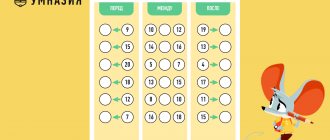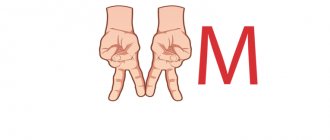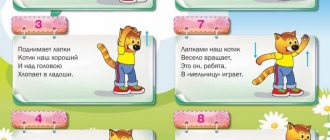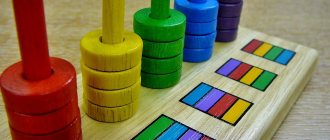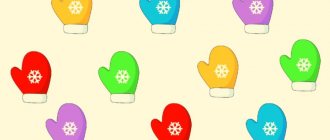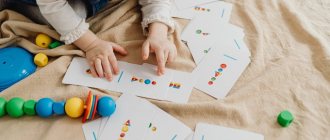Tasks set during classes
In outdoor games with a ball, preschoolers acquire the necessary skills and abilities. Children learn to clearly and calmly perform the exercises given by the teacher. Develops manual dexterity and improves physical fitness.
| № | Action | Skills children need to acquire |
| 1 | Pushing and rolling | vigorous pushing with hands, rolling between objects |
| 2 | Catching | catching with hands without pressing to the chest; catching with subsequent passing to each other |
| 3 | Reception | reception with both hands at the same time |
| 4 | Throwing and passing | two-handed throws throws to a clearly defined location transmission from the chest, from behind the head, from below |
| 5 | Batting | vigorous beating with hands |
The children also get acquainted with the properties of the ball itself: volume, shape, dynamics. Training must be done with both large and small balls.
General recommendations for working with preschoolers
Preschool workers can use videos from the Internet to compile teaching materials. At home, children do not always have the opportunity to play in the yard with friends. Therefore, in the summer outdoors, the main burden of teaching children to play sports falls on the shoulders of teachers.
Competently compiling a card index will help maintain the interest of preschoolers, while the program should exclude unsafe games.
Children are interested in practicing with sports equipment during walks, so they need to be allowed to independently feel the peculiarities of the behavior of the playing equipment in motion.
Each child should be covered by the attention of the teacher during classes. Appropriate praise coming from an adult will facilitate effortless performance of the exercises.
Proper alternation of intervals of free play and completing tasks will allow you to select the load and not overtire preschoolers.
Ball games for children 2-3 years old in kindergarten should be aimed at actively developing hand motor skills. It is recommended to develop the habituation to the ball gradually, this will allow you to develop confident movements.
Younger preschoolers better perceive exercises in which actions are accompanied by playful comments coming from the teacher:
- "the ball wants to play with you"
- “Hold the ball tightly so it doesn’t run away.”
You need to talk through what is happening on the site or in the room all the time. Children can get bored with monotony, so the correction of tasks and their change should be under the control of the teacher.
Fitball - gymnastics for preschoolers
PROGRAM for a physical education instructor for implementation in preschool settings
Explanatory note
Disappointing statistics on the deterioration of children's health poses the task of preschool organizations to search for new forms of physical education and health activities aimed at strengthening and preserving the health of pupils. In physical education classes, much attention is paid to the formation of correct posture, improvement of coordination of movements, development of activity, endurance, and flexibility. Gymnastics using a “Fitball” ball (“fit” - health improvement, “ball” - ball) opens up the opportunity in a playful way to form correct posture, strengthen the muscle corset, develop the musculoskeletal system,
develop coordination of movements, develop the vestibular apparatus, stimulate the balance function, adapt the body to stress, improve blood circulation, improve metabolism, and gain a positive emotional mood. The introduction of fitball-gymnastics fits quite easily into the educational process of preschool educational institutions. The main form of work is physical education and sports entertainment. Fitball gymnastics is based on general developmental exercises. Physical education classes with fitball are conducted in the traditional form in parts: preparatory, main and final.
SEE ALSO Summary of a lesson with fitballs in the preparatory group
The preparatory part includes walking around the balls, “snake” between the balls, running around the balls, one after another, holding the ball by the “horns” on the back. Springy rocking ensures alignment of the back, stimulates coordinated activation of the spinal muscles; train the correct installation of the center of gravity with a dynamic basis in supporting the torso.
In the main part of the lesson, i.p. are used. - lying on your stomach on the ball, lying on the floor with the ball under your feet, jumping on the ball moving forward, rolling on your stomach on the ball. Exercises performed in these i.p. allow you to develop and gradually increase muscle strength endurance and coordination of movements; strengthen the body's nonspecific defenses.
The final part consists of walking around balls and performing exercises. — sitting on a ball, accompanied by slow music for relaxation and restoration of breathing.
The program provides:
1. Health-improving effects of Fitball-gymnastics on children’s bodies 2. Continuity in solving problems with the educational program of preschool educational institutions 3. Creation of conditions for Fitball-gymnastics
Goal of the program: Development of physical qualities and strengthening the health of children.
Program objectives:
1. Wellness:
- promoting children's health
- prevention of postural disorders
- increasing the body's resistance to adverse environmental factors
2. Educational:
- expansion of the child’s motor sphere
3. Educational:
- nurturing interest and need for daily physical exercise
- establishing the foundations of a healthy lifestyle
Material support:
- gym
- fitballs for a group of children: you will need fitballs of different diameters from 30 to 40 cm with “pimples” that create a massage effect and allow the child to stay on the ball, as well as with horns or handles that children will hold on to while doing exercises
- laptop Some exercises are performed with musical accompaniment; older children are shown a video of the exercises being performed
Program content
Acquaintance with fitball begins with the 2nd junior group, children are given an idea of the properties of the ball in a playful way, are invited to play with the ball, how children react to the ball is observed, exercises “Capture”, “Chair”, “Catch up with the ball” are shown, children can perform some exercises under the supervision of a physical education instructor. In the middle group, children perform “Spring”, exercises: “Let’s swing”, “Jolly legs”, in older preschool age fitballs are used in relay races.
The duration of one lesson in the junior group is 15 minutes, in the middle group - 20 minutes, in the senior group - 25 minutes, in the preparatory group - 30 minutes.
Number of classes: one lesson per month in terms of direct educational activities in physical education + 1 sports leisure per year using fitballs
Methodology.
The effectiveness of fitball gymnastics depends on the correct selection of teaching methods and techniques. When teaching physical exercises on a fitball, it is used
- demonstration when introducing children to new movements (the movement is demonstrated several times)
- imitation, the technique of imitating the actions of animals or phenomena of nature and social life, is very helpful in teaching children physical exercise. Imitating, for example, the actions of a bunny, children get into character and jump on fitballs with great pleasure. The positive emotions that arise in this case encourage you to repeat the same movement many times, help consolidate a motor skill, improve its quality, and develop endurance.
- verbal techniques, because many physical exercises have conventional names that reflect the nature of the movement, for example: “Boxer”, “Roll”, older children can perform them without being accompanied by a demonstration
- visual techniques using aids to clarify the construction in the form of a diagram, photograph, video clip
- visual cues that help children clarify directions of movement and diversify their activities
- Sound landmarks are used to master the rhythm and regulate the tempo of movements on the fitball, and also as a signal for the beginning and end of an action, for emotional uplift. Musical accompaniment, drumming, clapping, etc. are used as sound cues.
- The plot story is used to arouse children’s interest in activities and the desire to become familiar with the technique of performing them. For example, the teacher tells the fairy tale “Kolobok”, and the children do the corresponding exercises
- conversation helps to find out the interests of children, helps to clarify, expand, generalize knowledge and ideas about the technique of physical exercises on a fitball
- individual assistance is used to clarify the fit on the fitball, to create the correct muscle sensations, create confidence, success
In order to consolidate motor skills, exercises on fitball are carried out in game and competitive forms. As a result, a special physiological and emotional background arises, enhancing the impact of exercise on the body, promoting the manifestation of maximum functionality and mental strength. At the same time, higher demands are placed on physical and moral-volitional qualities: determination, honesty, nobility.
Long-term plan for teaching fitball exercises
1 year of study
Equipment:
Fitballs according to the number of children Laptop for playing music
Lesson No. 1 (September)
Objectives: To attract children's interest in fitball, to give ideas about the shape and physical properties of fitball.
Optional equipment:
Gymnastic board length. 2.5 m, wide. 25 cm.
Progress of the lesson:
There is a fitball in the center of the hall, children enter the gym, form a circle, and the physical education instructor points to the ball:
I have a big ball. This ball doesn’t bounce on its own, but I can jump on it for a long time.
Sits on the ball, swings in place
Do you like children ball? Let's play with him.
To the musical accompaniment of E. Zheleznov “Pass the ball.” children pass the ball around the circle, then the ball returns to the center.
Instructor: You met the ball, it’s called a fitball, what kind of ball?
Large, round - spreads his arms to the sides, outlining a large circle, children repeat;
It has air inside, it can be pumped up - bending forward “Pump”;
Soft, rubbery, you can swing on it - the spring is in place, the farts are behind your back;
Elastic, you can jump on it - jumping on two legs in place, hands on the belt.
The ball has horns, they are comfortable to hold on to, and you can also imagine that it is a goat with horns and he wants to play with you.
Children turn to the physical education instructor and perform the following movements to the song “Kozlik” performed by the children’s folk ensemble “Dobryashki”: walking alternating with jumps, walking on a gymnastic board, jumping over a line
Instructor: We had a lot of fun, and now we can work hard, he draws the children’s attention to the fitballs that lie against one wall of the gym. Help me roll the fitballs to the other side of the hall.
The game “Ride the fitball” is being played
Children choose a fitball and roll it with both hands in a straight line.
Instructor: Praises the children, offers to stroke the Fitball and press it with their hands. We've done a good job, we need to rest. Walking behind the instructor around the room, forming a circle.
Instructor: Did you like playing with the fitball? What do you tell your mom about the big ball?
Children's answers.
Lesson No. 2 (October)
Objectives: To consolidate children’s understanding of the shape and physical properties of fitball. Give the idea that you can perform exercises with a fitball. Teach the approach to the fitball, take the basic position to perform the exercises.
Fitballs lie in two rows in the center of the gym, growing. between balls 60 cm, between rows 1.5 m.
Progress of the lesson
Children enter the hall one after another and line up along the landmarks on one side of the hall.
Instructor: We have big balls again, who can remember what they are called.
Children's answers. If the children name the ball, the instructor praises them; if they find it difficult, he reminds them that this is a Fitball, a training ball. Let's start our workout with walking and then play with balls. To the musical accompaniment of “race walking”, children turn around and follow the instructor. Walking is normal, on their toes, holding their hands up, in a snake between the fitballs, scattered between the fitballs, formation at the fitballs. Crawling on all fours around your exercise balls. Exercise with a fitball to the musical accompaniment of “Crane”
“Squats” (training) IP: standing facing the ball, hands free; on the count of 1-2, sit down, put both hands on the fitball, spread your knees to the sides, keep your back straight; at 3-4 stand, leaning on the ball, hands freely - repeat 3 times, after which, at a signal, the children run scattered between the fitballs, at the next signal they run up to their fitballs and repeat the exercise 3 more times.
Outdoor game “Who will throw the fitball further”
From a standing position in a line, children raise the fitball up with both hands, on the command “Throw”, throw the ball forward, see whose ball flew further, on the command “Take”, take the ball, return to their place.
Children take the balls by the horns, hold them behind their backs, walk around the hall one after another, take the balls to their place, and line up in a circle.
Instructor: Today we played different games with a fitball, which games did you like? What is the name of the ball, is the ball heavy or light? What will you tell your parents about our lesson?
Lesson No. 3 (November)
Objectives: To consolidate children’s understanding of the shape and physical properties of fitball. Teach basic positions when performing exercises with a fitball.
Fitballs lie on one side of the hall
Progress of the lesson.
To the musical accompaniment of “race walking,” children enter the hall and perform various types of walking: regular walking, walking on toes, walking with high knees, diagonally behind the instructor. Take fitballs and line up in a circle. Exercise “Pass the ball”: children pass the ball to each other in a circle in one direction and the other. Performed to the musical accompaniment of E. Zheleznov “Pass the ball.”
“Squats” (fastening) IP: standing facing the ball, hands free; on the count of 1-2, sit down, put both hands on the fitball, spread your knees to the sides, keep your back straight; at 3-4 stand, leaning on the ball, hands freely - repeat 3 times, after which, at a signal, the children run scattered between the fitballs, at the next signal they run up to their fitballs and perform the exercise “Capture” (training), etc. kneeling facing the fitball, hands on the fitball; on the count of 1-2, lower yourself onto your heels, press the fitball to your knees with your hands; on the count of 3-4, return to IP. - repeat 3-4 times, stand on your feet, jump around your fitball, repeat the “Grab” exercise 2 times.
Outdoor game
“Crane” exercise with a fitball accompanied by music “Crane”
Children take the fitballs to their place, breathing exercises “Pump” are performed (inhale through the nose, exhale through the mouth) “Let’s pump up the fitball.”
Instructor: Who will tell you what kind of fitball it is (big, round, elastic, has air inside, rubber). How many of you have a fitball at home? How do you play with it?
Lesson No. 4 (December)
Objectives: To reinforce the concept that you can perform exercises with a fitball. Teach the approach to the fitball, take the basic position to perform exercises from the starting position lying on the floor
Optional equipment:
Two gymnastic benches
Fitballs lie in two rows in the center of the gym, growing. between balls 60 cm, between rows 1.5 m.
Progress of the lesson
Children enter the gym and line up near the fitballs. Walking in all directions between fitballs, running in all directions between fitballs, game exercise, “Take a seat”, at the instructor’s signal, children quickly stop near the fitball - 2 times
Stand near the fitball, set of exercises “Clap with us” to the musical accompaniment of “Fun exercises”
“Squats” (repetition) IP: standing facing the ball, hands free; on the count of 1-2, sit down, put both hands on the fitball, spread your knees to the sides, keep your back straight; at 3-4 stand, leaning on the ball, hands freely - repeat 3-4 times, after which, at a signal, the children run scattered between the fitballs, at the next signal they run up to their fitballs and perform the exercise
“Capture” (fastening) etc. kneeling facing the fitball, hands on the fitball; on the count of 1-2, lower yourself onto your heels, press the fitball to your knees with your hands; on the count of 3-4, return to IP. - repeat 3-4 times, after which, at a signal, children run scattered between the fitballs, at the next signal they run up to their fitballs and perform the exercise
“Gorka” (training) IP: lying on your back, on the floor, hands free; on the count of 1-2, place your straight legs on the fitball; on a count of 3-4, lower your legs to the floor through the sides, repeat 3 times at an individual pace.
Game exercise “Roll the ball”: children roll a fitball on a gymnastics bench in a continuous manner. After rolling the balls, the children leave them on one side of the gym and line up on the other side of the gym.
Outdoor game “Who can reach the fitball faster” - crawling on all fours
The instructor praises the children and asks them to form a circle, walking in a circle holding hands.
Instructor:
We take a round ball, go play football, drive around the court and score a goal with it. We also have a ball, spiky and big. Children like to play with it. It’s called Fitball.
Instructor: Do you like to do exercises with a fitball, which exercises did you like best? You are doing well, you are great.
Lesson No. 5 (January)
Objectives: Continue to teach children to take the basic position for performing exercises from the starting position lying on the floor, introduce new exercises
Equipment:
Big hoop
Fitballs lie along the walls of the gym, growing. 1 m between them.
Progress of the lesson.
Forming in a circle, walking in a circle as usual, on toes, with high knees, running as usual, on toes, formation in a circle. Instructor:
Today we are going to have fun exercises with a big ball, what is it called?
Children: Fitball!
Exercise “Pass the ball” to musical accompaniment.
Game "Take a seat" Children run scattered around the hall, stopping near the fitballs (facing the fitball, the fitball rests against the wall)
“Steps” (training) etc. lying on the floor on your back, put your feet on the fitball, take small steps up and down the fitball, perform at your own pace
“Capture” (repetition) etc. kneeling facing the fitball, hands on the fitball; on the count of 1-2, lower yourself onto your heels, press the fitball to your knees with your hands; on the count of 3-4, return to IP. - repeat 3-4 times, after which, at a signal, the children run scattered between the fitballs, at the next signal they run up to their fitballs and perform the next exercise
“Slide” (fastening) IP: lying on your back, on the floor, hands free; on the count of 1-2, place your straight legs on the fitball; on a count of 3-4, lower your legs to the floor through the sides, repeat 3 times at an individual pace.
“Shocked the ball” (training) etc. lying on your back, legs on the fitball, arms along the body, swing the fitball with your legs left and right in any form
“Clamp” (training) IP: lying on the floor on your back, straight legs on a fitball, arms along the body; at a slow pace, lower your legs to the floor from the sides, squeeze the ball with your feet, try to lift it with your feet.
Children take the ball by the horns and line up in a circle.
Exercise with a fitball to the musical accompaniment of “Crane”
The outdoor game “Get into the Hoop”, children throw the ball into a large hoop in a continuous manner, follow the ball themselves into the hoop, and catch up with the ball.
Children take the balls by the horns, hold them behind their backs, walk around the hall one after another, carry the balls to their place, and line up in scattered formations.
Instructor: What did you like during the lesson, who practices with fitball at home, what do you like about playing with fitball.
Lesson No. 6 (February)
Goal: To consolidate the skills of performing exercises with a fitball while lying on the floor, to teach how to take a lying position on a fitball.
Fitballs lie in a circle in the center of the gym. Children enter the gym and line up in a circle. Walking with changing tasks behind the physical education instructor, to the song “Goat” performed by the children’s folk ensemble “Dobryashki”.
Stand near the fitball, set of exercises “Clap with us” to the musical accompaniment of “Fun exercises”
"Capture" etc. kneeling facing the fitball, hands on the fitball; on the count of 1-2, lower yourself onto your heels, press the fitball to your knees with your hands; on the count of 3-4, return to IP. - repeat 3-4 times, after which, at a signal, the children run scattered between the fitballs, and at the next signal they run up to their fitballs.
The following three exercises are combined into one
“Slide” (fastening) IP: lying on your back, on the floor, hands free; on the count of 1-2, place your straight legs on the fitball; on a count of 3-4, lower your legs to the floor through the sides, repeat 3 times at an individual pace. “Shocked the ball” (training) etc. lying on your back, legs on the fitball, arms along the body, swing the fitball with your legs right and left in any form “Clamp” (training) etc.: lying on the floor on your back, straight legs on the fitball, arms along the torso; at a slow pace, lower your legs to the floor from the sides, squeeze the ball with your feet, try to lift it with your feet.
The instructor praises the children and tells them that you can lie down on a fitball, would you like to try it? Don't rush anywhere, you can fall off the ball, watch how I do it. Shows. He invites daredevils to try on their own; he works with the rest individually; it is important that the children are not afraid. The exercise is performed at an individual pace, in a good mood, the instructor encourages the children. Children lie down on the ball, after a while they get up and lie down again; those who confidently stand on the ball can sway.
Outdoor game
“Kick the ball!” - pushing the ball with the back of the foot to the indicated place.
Children take the balls by the horns, hold them behind their backs, walk around the hall one after another, carry the balls to their place, and line up in scattered formations.
Instructor: Did you like lying on your back, is it easy to hold on to the fitball while lying down, can you lie on the fitball and sway. What will you tell your parents about this evening? What is the name of the exercise ball?
Lesson No. 7 (March)
Goal: To consolidate the ability to take a lying position on a fitball. Learn to perform rocking movements while lying on a fitball on your stomach.
Progress of the lesson
Fitballs lie in two rows in the center of the gym, growing. between balls 60 cm, between rows 1.5 m.
Children enter the hall one after another and line up near the Fitballs.
Instructor: We have big balls again, who can remember what they are called. Walking randomly between the balls, observing the condition of not moving the balls from their place. Walking is performed to the musical accompaniment of “race walking”
Children stop at the fitballs and perform the “Crane” exercise to the accompaniment of music.
“Lay down”: lie down on the fitball with your stomach, hold on, at an individual pace. “Swing” while lying on a fitball, perform swaying while supporting your legs, use your hands to maintain balance
Take the fitballs, line up in a line, play “Who’s Next” and roll the fitball with your hands from a standing position forward 2 times.
Children take the balls by the horns, hold them behind their backs, walk around the hall one after another, take the balls to their place, and line up.
The instructor invites the children to share their impressions of the new exercise.
Lesson No. 8 (April)
Goal: To consolidate the ability to take a position lying on a fitball, perform rocking while lying on a fitball on your stomach. Learn to sit on a fitball against the wall.
Fitballs lie along the walls of the gym, growing. 1 m between them.
Progress of the lesson
Form a column one at a time. Walking in a column, one at a time, is normal, on toes, with high knees, with a transition to running, normal running, on toes. Formation in a circle.
A set of exercises “Clap with us” to the musical accompaniment of “Fun exercises” Running in all directions, lining up near the fitballs (against the wall)
“Chair” (training) children are invited to try to sit on a fitball against a solid support, their feet are pressed to the floor, standing parallel to each other) Each child is provided with individual assistance. The exercise is performed slowly; those who confidently sit on the fitball can swing.
Children are invited to take a fitball, move away from the wall, and perform the exercise lying on the fitball: “Lie down”, “Swing”
Game exercise with fitball accompanied by musical accompaniment “Crane”
Instructor:
The ball is made of rubber. If you press it, it takes off like a spring, we have fun playing with it
Outdoor game “Throw, catch up”, children throw the ball forward, catch up with it and throw it again
Leave the balls on the floor. Walking between fitballs. Low mobility game “Find your fitball and take it to its place”
The instructor praises the children, what have we learned today, it’s hard to sit on a fitball, what can you tell us about our lesson at home?
Lesson No. 9 (May)
Goal: performance diagnostics
Criteria for evaluation
High level Confidently approaches the fitball, independently maintains balance while lying on the fitball, acts according to the instructions of the instructor.
Intermediate level Confidently approaches the fitball, with the help of the instructor lies down on the fitball, tries to maintain balance, acts as directed by the instructor at a general pace.
Low level Does not approach the fitball with confidence, performs exercises with tension even with the instructor’s safety net, does not maintain balance on the fitball, and needs additional individual work.
Exercise technique
When making throws on the floor (road), first of all you need to pay the guys’ attention to the peculiarities of the movement. Children need to understand the relationship between the force of the throw and the height of the jump.
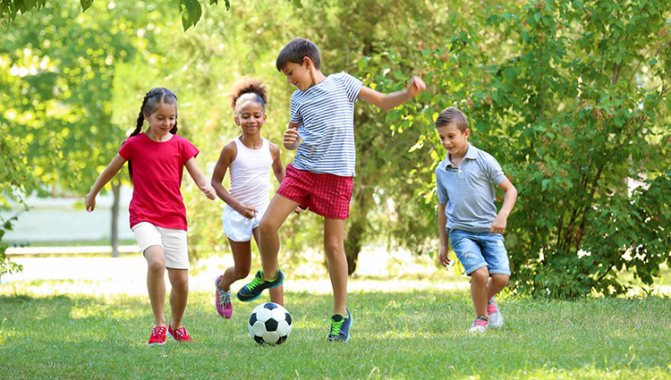
When practicing throwing at a target, it is important to explain:
- how to take the correct starting position of the body,
- how to perform hand movements,
- the need to monitor the movement of the projectile and the target when throwing.
When throwing with two hands, it will not be superfluous to practice the following technique: the preschooler throws the ball on the floor and then catches it. The force applied to the projectile must be varied.
The exercises are changed only after everyone has completed the required number of approaches. All the guys are definitely involved in the games.
The correct transmission is not mastered immediately. We must strive to ensure that preschoolers follow the movement of the ball with their eyes, press their elbows to their body, and point the projectile at the chest level of another child.
Throwing into the basket also requires some skill. Mastering the correct body position, observing the movement of a projectile, and the ability to aim require a clear explanation and patience from the teacher.
Exercises with a ball. physical education card file (senior group) on the topic
Ball exercises
I. p. (starting position). O. s. (main stand). Ball in one hand.
1. Hands forward, show the ball, move your hands back - down, hide the ball.
2. Stretch your arms forward, transfer the ball from your right hand to your left, from your left to your right.
3. Transfer the ball below in front of you from one hand to the other and vice versa.
4. Hands to the sides at shoulder level, bring them together, stretching them forward, transfer the ball alternately from hand to hand.
5. Raise your arms above your head and pass the ball.
6. Extend your arms forward at shoulder level. Raise them forward and up above your head and pass the ball.
7. Rising on your toes, spread your arms upward, take the ball with both hands, look up, lower your arms down through your sides, the ball remains in the other hand.
8. Place your foot on your toes forward (backwards, to the left, to the right), raise your arms forward and up, lower them, hide your hands back, transfer the ball to the other hand.
9. In pairs, one step apart, one has the ball in his right hand, the other in his left. Stretch your arms forward, pass the ball to your partner with your right hand to your right (left to your left).
10. Raise your arms to the sides, lower them forward and down through the sides, transfer the ball, raise them to the sides, lower them back and down, transfer them to the same hand again.
11. Complete all exercises, but only with two balls.
12. Do the exercises at a fast pace.
13. Transfer the ball from one hand to the other several times in a row.
14. Transfer two balls from one hand to the other at a slow and fast pace.
15. Shift the ball, alternately lifting the right (left) leg, bent at the knee or straight.
16. Lean forward, put the ball on the floor, straighten up, lean forward, pick up the ball with the other hand.
17. Hands to the sides, each holding a ball. Squat down, put the balls on the side. Turn around, take the balls, stand up.
These exercises help develop the muscles of the shoulder girdle, develop attention and dexterity.
Tossing exercises
I. p.: o. With. Ball in one hand.
1. Throw the ball up, catch it with both hands (12-15 children perform it at the same time); catch with your right hand; catch with your left hand.
2. Throw the ball on the floor, clap your hands, catch it with both hands.
3. Throw the ball high up, let it hit the floor, catch it with both hands; alternately right and left; catch after turning around.
4. Hit the ball against the wall, catch it with both hands; Before catching the ball, jump on one or both legs.
5. Throw the ball against the wall, after bouncing off the floor, catch it with both hands; one hand at a time.
6. Hit the ball on the floor so that it touches the wall and catch it.
7. Hit the ball on the floor, let it touch the floor again and catch it.
8. Dribble the ball with one hand, like a basketball: in place; squatting; standing; with moving forward; bypassing objects.
These exercises develop a sense of the ball, coordinate movements, develop dexterity, and serve as the first step to further mastery of more complex games.
General developmental exercises with a large ball.
1. I.p.: o.s., ball in both hands below. 1-2 – lift the ball up, rising on your toes; 3-4 – I.p. (6-7 times).
2. I.p.: standing on your knees, the ball in both hands in front of you. 1-4 – roll the ball around you to the right; 5-8 – left (6 times).
3. IP: sitting legs apart, ball in bent arms in front of you. 1-2 – bend over, roll the ball from one foot to the other; 3-4–I.p. (6 times).
4. I.p.: lying on your back, legs straight, ball in both hands behind your head. 1-2 – raise your right leg bent at the knee, touch the ball; 3-4 – I.p. The same with the left foot (6 times).
5. I.p.: o.s., ball in bent arms in front of you. Throw the ball up randomly and catch it with both hands (5 times), then pause and repeat again.
6. I.p.: o.s., ball in bent hands. 1 – sit down, bring the ball forward, arms straight; 2 – I.p. (6 times).
7. I.p.: o.s., ball on the floor, hands on the belt. 1-8 – jumping around the ball on two legs (3-4 times).
Methods of working with children
Individual work is needed with children who were unable to complete the exercises. The development of motor skills occurs most effectively while playing with a ball in kindergarten. Attention to each individual child is an integral part of the correct upbringing process.

Lengthy explanations during play are poorly received by preschoolers, and therefore it is better to use short comments. It is recommended to celebrate achievements and successes in front of the whole group.
Children participating in throwing games should be taught that:
- you need to be careful when fishing,
- do not throw at the head and feet area,
- It’s worth calculating your strength to avoid injuries to other guys.
Interest in games largely depends on the teacher. Criticism and comments should not be presented in a form that will reduce interest in the exercises.
Games for older preschoolers
Ball games in the courtyard of a kindergarten for children 6-7 years old should be studied by teachers and entered into a file cabinet. The necessary equipment will not be difficult to find in the play area or to make during classes at the preschool educational institution. If the weather allows you to go out into the yard, then ball games for preschoolers are very interesting and educational.
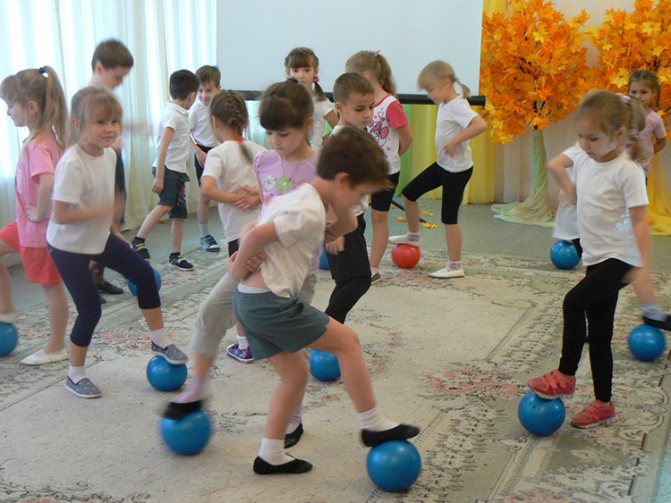
“Ball, fly!”
Goal: ability to jump high and fast.
- Participants stand in a circle. The teacher chooses a driver who stands in the center and gives him a wand. Children are kept at a distance of 80 cm from each other.
- Each child is given 5 rubber bands that they can put on their hand.
- The players throw the ball to each other. The driver tries to touch him with a stick. The round lasts approximately 2 minutes.
- If the driver touches, then the player who threw the ball gives 1 rubber band to the driver and stands in the center instead of him.
- The number of rounds corresponds to the number of participants. The player who collected the most rubber bands wins.
Peculiarities:
- children throw the projectile to each other as quickly as possible; when catching, players can move;
- touching the projectile while it is in the participant’s hands does not count;
- the number of rubber bands can be more than five.
“Fun Races”
Ball relay races for preschoolers foster a healthy spirit of competition. There are many variations of the rules, depending on the number of participants and their wishes.
Goal: improve agility.
- Children are divided into 2 teams with the same number of players and stand in 2 ranks one after another.
- At the signal, the children begin to pass the ball to each other from the one in front to the one on the other side and back. The projectile is alternately passed over the right and left shoulders. That is, if one child passed through the right, then the next one after him passes through the left.
- The team that returns the projectile to the first player first wins.
Peculiarities:
- teams start the game at the same time;
- The sequence of turns over the left and right shoulders during the relay must be strictly observed.
“The watchman never sleeps”
Goal: development of mindfulness.
- The teacher draws a circle with a diameter of approximately 7 m if there are 10-12 players.
- In the center of the circle you need to build a town with gates located in a circle.
- Participants are divided into teams of Watchmen and Mice. Each mouse is given 1 small ball. Each gate has its own Watchman. The mice stand along the line of the circle.
- The task of the mice is to send a projectile with their feet so that it hits the gate. The Guardians' task is to hit the ball so that it flies out of the circle.
- The Mouse who missed his projectile beyond the circle line and the Watchman who missed his goal are eliminated.
- The team with the most members left at the end of the game wins.
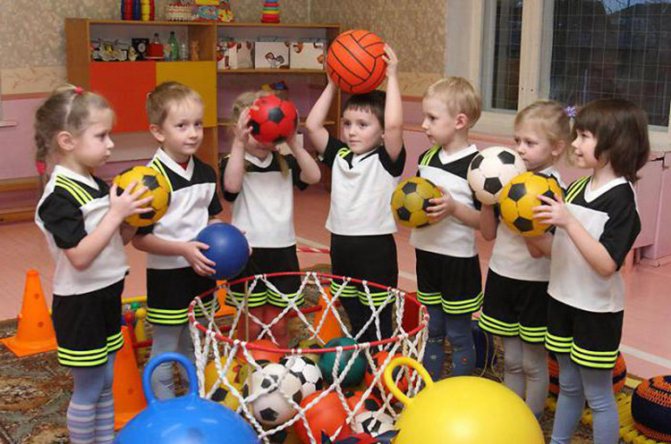
Feature: the guard can only kick.
"Mini football"
The game is played outdoors and will appeal even to teenagers aged 10-12 years. Playing a variation of football outdoors will require the creation of two teams of players. In the future, with regular training, the children will become virtuoso dribblers. Acquired agility and speed will allow you to feel confident in football competitions.
- Assemble 2 teams of six people.
- Build a gate from cubes or other suitable equipment.
- The guys score goals against each other and play without grabbing their opponents' clothes or hands.
- During one game you can take breaks of 6-7 minutes.
- The team that scores the most goals wins.
Features: The rules can be changed before the start of each game, but not after the start.
Indoor ball games for children 6-7 years old should be suitable for limited space and accompanied by music. If the year turns out to be cold and rainy, then the opportunity to go out into the garden courtyard will not come often.
A good card index includes outdoor games with elements:
- throwing a projectile into a basket,
- passing the ball to a small circle of participants.
Classes, exercises and games with balls, on balls, in balls. Training, correction, prevention
Activities to preserve and strengthen the health of children in preschool institutions have not lost their relevance, but have become even more urgent in the context of reform and modernization of the education system. The requirements for the content of educational programs and their material support have increased, the population of pupils has changed: more and more “at-risk” or “conditionally healthy” children are appearing in preschool educational institutions. In accordance with the ideas of inclusive education, children with speech disorders, mental development delays, and musculoskeletal disorders, who are called children with disabilities (CHD), appear in groups of general education preschool educational institutions. The range of differences in the development of children with disabilities is extremely large - from almost normally developing children experiencing temporary and relatively easily remediable difficulties to children with irreversible severe damage to the central nervous system. The definition of “conditional health” and “degree of normality of a person” is very abstract, since the “norm” in relation to the level of psychosocial development of a person is increasingly “blurred”.
According to neonatologists, currently only 5% of children are born absolutely healthy, while the remaining 95% have organic brain damage of varying severity.
The decline in health indicators and the rate of development of preschool children is due to the deterioration of socio-economic and environmental living conditions, unbalanced nutrition, and a decrease in health-improving and educational work in preschool educational institutions. An analysis of the health status of children shows that the proportion of healthy children is significantly decreasing, and the number of children with chronic diseases entering kindergarten is increasing every year. All these children at the stage of entering school are characterized by a low level of school maturity, experience difficulties in learning and in mastering the social role of a student, and have an increased risk of school maladjustment. These children are considered a risk group.
At the same time, more and more in modern schools the dominance of “intellectual” education is felt, as a result of which children’s health suffers. The variability of preschool and school education, the intensification of learning and the increase in the volume of teaching and educational loads, and the expansion of the range of additional educational services often leads to inadequate overload for children, turning educational activities into a risk factor for their health. As a result of scientific research, numerous confirmations have been obtained of a clear dependence of the degree and nature of deterioration in children’s health on the volume and intensity of educational loads, the uniqueness of relationships in the “teacher-child” dyad, as well as on various options for organizing the educational process.
A preschool institution is faced with a problem: how to ensure the fullness of a child’s life today and determine the conditions for a healthy developmental environment necessary to increase the adaptive psychophysical capabilities of preschool children? In conditions of increasing volume and intensity of educational and cognitive activity, increased requirements for knowledge when entering school, the harmony of psychophysical development is impossible without scientifically based technologies that increase the adaptive capabilities of children to various types of loads and stress.
In modern preschool education, direct attention is paid to the physical education and health direction in the development of children, which includes various types of gymnastics, massage and self-massage, physical education classes, and outdoor games. All these forms of work are implemented by physical education leaders in specially organized forms of health-improving work and by educators in classes, walks, during restricted periods and in free children’s activities. In accordance with the transition from the concept of education based on the formation of knowledge, abilities and skills to the concept of education based on the formation of competencies in preschool institutions, regulated educational activities are being replaced by free joint actions of teachers with children, where play occupies a special place. The importance of outdoor play for a child is great - it is a school for managing one’s own behavior, forming positive relationships with peers, and a prosperous emotional state. Outdoor games provide an opportunity to develop children’s speed-strength and coordination motor abilities, and to demonstrate physical qualities such as endurance, strength, and flexibility. In games with elements of sports, the senses of muscle effort, space, time are improved, and the functions of all sensory analyzers are improved.
Ball games occupy a special place among outdoor games. The ball is a ball, an ideal cosmic shape, the most perfect geometric figure, having neither beginning nor end. No body of any other form has a larger surface of contact with the palm, which gives a complete sense of form. It is not without reason that one of the outstanding German pedagogues and philosophers of the 19th century, Friedrich Froebel, considered the ball one of the great gifts of pedagogy and called it “an ideal means for exercise.” The ball sends optimal information to all analyzers. The joint work of the motor, vestibular, visual and skin (tactile) analyzers, which are activated when performing exercises with a ball, enhances the effect of the exercises. Modern balls often also have different odors, allowing you to use your sense of smell along with the listed analyzers, which makes the activity more attractive and desirable.
Froebel, noting the versatile impact of the ball on the psychophysical development of a child, emphasizes its role in the development of coordination of movements, the hand, and, consequently, in activating the work of the brain. He believed that almost everything a child needs for his comprehensive development is given to him by the ball. Particularly important are games in which the child’s actions with a ball are accompanied by words and songs appropriate to the moment and mood.
In the system of physical education developed by P. F. Lesgaft, ball games also occupy an important place. While playing, a child performs various manipulations with the ball: aiming, hitting, throwing, throwing, combining movements with claps, various turns, etc., which contributes to the development of the eye and motor coordination functions. According to A. Lowen, hitting a ball improves mood, relieves aggression, helps get rid of muscle tension, and causes pleasure. Pleasure, in his opinion, is freedom of body movement from muscle armor, muscle tension.
The ball is a surprisingly interesting toy. Perhaps, people have not yet come up with anything similar - so simple and at the same time interesting. The ball is perceived by the child as something alive. He is sensitive and responsive to movement, can be obedient and mischievous, he is bright, round and very cute. You can play ball before you even learn to walk, and you can watch how people of very respectable age kick the ball around with ecstasy.
In the psychocorrection of children with disabilities, activities with balls can be carried out in different forms - from traditional activities and games with balls, to fitball gymnastics and games with balls, that is, in a dry pool filled with balls.
Psychocorrectional gymnastics on large balls (fitballs) is increasingly used in working with preschoolers. Fitball gymnastics ( English
. Fit-Ball, fit - health improvement, ball - ball) covers all possible aspects of using balls in accordance with the worldwide accepted system of health training (fitness). Large diameter balls - fitballs - appeared relatively recently. They have been used for medicinal purposes since the mid-1950s. Fitball has certain properties used for health, correctional and didactic purposes. This is the size, color, smell, and its special elasticity.
Balls can be not only of different sizes, but also of different colors. Different colors have different effects on a person’s mental state and physiological functions. Warm colors (red, orange) have an ergotropic effect, increase activity, and enhance excitation of the central nervous system. This color is usually chosen by active children with choleric traits. Cool colors (blue, violet) have a trophotropic effect, that is, they calm, they are usually chosen by children with phlegmatic features, calm, slightly inhibited, inert. Yellow and green colors promote endurance. With the help of flowers you can regulate a person’s psycho-emotional state. The signaling role of color in preventing injuries is great. Priority in the development of the “safety colors” system belongs to F. Birren. Thus, the black and brown coloring of the shells gives the impression that they are heavier than objects that are painted white and yellow. Warm colors enhance the perception of high ambient temperature, while cool colors weaken its perception.
In addition to the color effect on the body, fitballs also have a vibration effect.
Vibration activates regenerative processes, so this property is used in rehabilitation after various injuries and diseases of the musculoskeletal system. Vibration together with movement enhances impulses from proprioceptors, stimulating the motor zone of the cerebral cortex. Exercises riding on a ball contribute to the treatment of diseases such as osteochondrosis, scoliosis, neurasthenia, asthenoneurotic syndrome, etc. The therapeutic effect is due to biomechanical factors - this is primarily the effect of the vibrations of the ball on the spine, intervertebral discs, joints and surrounding tissues.
Balls allow you to individualize the therapeutic and educational process, specifically correct existing postural disorders without the use of special rollers and devices for areas of kyphosis or lordosis.
Correct landing on the ball provides for the optimal relative position of all parts of the body, while the most economical work of the postural muscles occurs to maintain the posture in the correct static position.
Exercises on the ball can be performed in different starting positions. The conditions for performing exercises while lying on a ball are much more difficult than on the floor - on a rigid, stable support, since the exercises are performed in constant balancing, while working the smallest and deepest muscles necessary to hold the torso in a symmetrical position.
Exercises in the starting position while sitting on a ball train the pelvic floor muscles, align the “oblique” position of the pelvis, which is also important for correcting scoliotic deviations of the spine in the thoracolumbar region. Rocking while sitting on a ball, like horseback riding, has a beneficial effect on the intervertebral discs, centering them and normalizing metabolic processes in them, as well as improving blood circulation, lymphatic drainage and cerebrospinal fluid dynamics of the spinal column.
Fitball exercises strengthen the muscles of the back and abdominals, create a good muscle corset, but most importantly, they form the difficult and time-consuming skill of correct posture developed under normal conditions.
In different countries, health programs for the use of large-diameter gymnastic balls differ not only in names (Swiss-Ball, Resit-Ball, Bodyball, Fit-Ball), but also in methods.
In the physical education section of the “Kindergarten Education Program,” children’s activities with a ball are included in classes starting from the second year of life. They occupy a significant place among other means of physical education and become more complex from group to group due to the introduction of additional tasks, as well as more complex methods of implementation. In the preparatory group for school, in addition to throwing the ball in different ways with various tasks, throwing at a distance and at a target, the formation of skills of dribbling (hitting the ball), catching, passing (throwing the ball to each other), as well as throwing the ball into the basket is provided.
Exercises in throwing and rolling balls contribute to the development of coordination, dexterity, rhythm, and coordination of movements. They develop the ability to grasp, hold, and throw an object, teach them to calculate the direction of a throw, coordinate effort with distance, develop expressiveness of movements, and orientation in space. Ball games are a kind of complex gymnastics. During their course, children practice not only throwing and catching a ball, throwing it into a basket, throwing it at a distance and at a target, but also walking, running, and jumping. These movements are performed in a constantly changing environment. This helps preschool children develop the ability to independently use movements depending on the conditions of the game. Their ability to make precise movements is still poorly developed, so any actions with the ball have a positive impact on the development of this quality.
Exercises with balls of various weights and volumes develop not only large, but also small muscles of both hands, increase the mobility of the joints of the fingers and hands, which is especially important for a six-year-old child preparing for school. When catching and throwing a ball, the child uses both hands. This promotes the harmonious development of the central nervous system and the whole organism.
In collective ball games, favorable conditions are created for the development of positive moral and volitional traits in children. Such games teach one to overcome selfish impulses and develop self-control. Getting acquainted with the conditions of the game, the child learns that he is not the only one who wants to act with the ball, that his actions should contribute to the success of the entire team. For the sake of the team's interests, the child often has to pass the ball to a partner when he has more favorable conditions for playing a successful game. The need to make quick, reasonable decisions and implement them correctly in the game helps to develop confidence and determination. In the game, the child always has the opportunity to test his strength and make sure that his actions are successful.
For modern children who do not have a “yard play childhood”, ball control is often extremely difficult, and therefore a special method of teaching ball control skills and elements of sports games in a preschool educational institution is necessary. For children at risk, mastering the ball has enormous psychocorrectional significance, since all children at risk are to one degree or another lagging behind their healthy peers in agility, speed, and endurance. Visual-motor coordination, attention, control and regulation of one’s actions require additional corrective development technologies.
The psychocorrectional additional program “Ball Games” is based on the requirements for the comprehensive development of motor function, the relationship between the physical, intellectual and mental development of the child. When drawing up the motor correction program “Ball Games”, the authors were guided by:
— an integrated approach to the selection of program content and methods of conducting classes, as well as to the development of management techniques for both organized and independent motor activity;
— high variability in the use of the proposed content (in physical education classes, dynamic hours, in sectional, individual work, independent motor activity).
Based on the standard requirements set out in the general education program, the authors propose to carry out the physical development of the child through involvement in sports games and exercises, taking into account the state of health, level of physical fitness and development. The program involves the use of sports games and exercises in combination with other physical education and health activities; it is focused on developing independence, self-control, the ability to act in a peer group, and take care of one’s health.
The following are identified as the main educational objectives:
- formation of a stable interest in ball games, a desire to use them in independent motor activities;
- enriching the motor experience of preschoolers with new motor actions, teaching the correct technique for performing elements of sports games with a ball;
— promoting the development of motor abilities;
— education of positive moral and volitional qualities;
- formation of healthy lifestyle habits.
What balls are suitable
Preschoolers need lighter balls than those used for ball games for teenagers. Familiarity with sports equipment should begin at an early age.
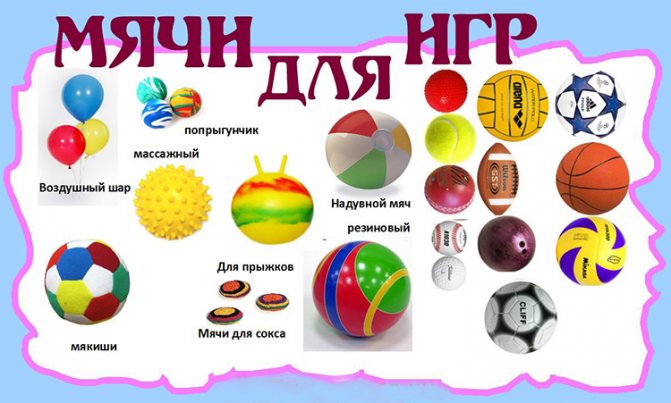
At 2-3 years old it will be useful to use a small massage ball. The manufacturing technology of equipment for babies eliminates the possibility of separating small parts that can be inhaled or swallowed.
For children 3-4 years old, large and small, but very light, inflatable balls are suitable. The impact of such a ball on a child should be practically not felt. This recommendation also applies to children 4-5 years old.
Children a little older (5-6 years old) can be given heavier inflatable balls that meet all safety requirements.
